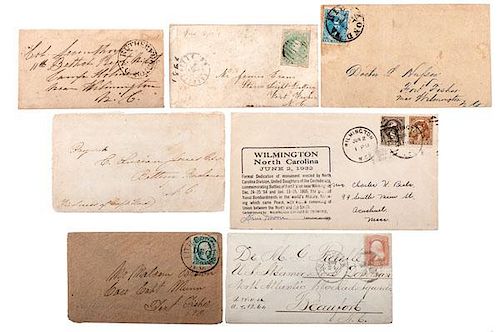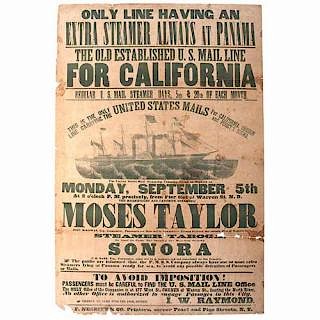Confederate Covers Addressed to Fort Fisher and the Surrounding Batteries
About Seller
6270 Este Ave.
Cincinnati , OH 45232
United States
With offices in Cincinnati, Cleveland and Denver, Cowan’s holds over 40 auctions each year, with annual sales exceeding $16M. We reach buyers around the globe, and take pride in our reputation for integrity, customer service and great results. A full-service house, Cowan’s Auctions specializes in Am...Read more
Two ways to bid:
- Leave a max absentee bid and the platform will bid on your behalf up to your maximum bid during the live auction.
- Bid live during the auction and your bids will be submitted real-time to the auctioneer.
Bid Increments
| Price | Bid Increment |
|---|---|
| $0 | $25 |
| $500 | $50 |
| $1,000 | $100 |
| $2,000 | $250 |
| $5,000 | $500 |
| $10,000 | $1,000 |
| $20,000 | $2,500 |
| $50,000 | $5,000 |
| $100,000 | $10,000 |
About Auction
Jun 10, 2016 - Jun 11, 2016
Cowan's Auctions dawnie@cowans.com
- Lot Description
Confederate Covers Addressed to Fort Fisher and the Surrounding Batteries
Lot of 7 covers (one with accompanying letters). Mounted as a display, "The Fort Fisher Story," plus one additional.
The first is addressed to Colonel Leventhorpe, 11th Bethel Regt., NC, Camp Holmes, near Wilmington, NC. Postal cancel Rutherfordton, NC, on a blue five cent Confederate States stamp at the closure of the envelope on verso. Second postal cancel in upper right on recto of envelope. A British army captain who came to America to prospect for gold before the war, Collett Leventhorpe enlisted as a colonel in October 1861 and was commissioned into the 34th NC Infantry. Five months later, he transferred to the 11th NC. He was wounded at Gettysburg on the first day, and captured on July 5th. He was taken to a Federal Hospital, then sent to Fort McHenry in September. He transferred to Point Lookout in Jan. 1864, and was exchanged shortly after and resigned in April, apparently never having fully recovered from his wounds.
There are two letters that may have been in one envelope, addressed to Paymstr C. Lucian Jones, CSA, Battery Buchanan, NC from his wife. The first is a short note dated 26 Dec. 1864 which mostly mentions family and a few friends and their plans to either move or stay put. The second is dated the following day. In this one she mentions that they can hear big guns from where they are. From her comments, it sounds as though she and one set of parents took rooms in a boarding house in Wilmington. Apparently she had also trusted people to deliver the notes, since the envelope is stampless. She notes:
Darling if you wish any thing sent down can you not send word by Mr. Carter or some reliable person, can you not send up your soil clothes in the basket or bucket so I can have them ready when you come.
I sent all our things off yesterday up to Fayetteville, so that at the last moment I would have nothing to trouble me when I had to leave, Ma sent nothing as she does not expect to leave at all.
Poor Brother is still up stairs, Genl. Bragg has gone down to the sound. Pa went to see him but he had left, no one has been here since that night for Brother.
Pa was on guard from 2 o’clock this morning until eight. Of course Ma made herself miserable, indeed she sat up until two o’clock so afraid Pa would not be in time and yet miserable about his going they want him our again to night that is too often for an old man like him.
The third is a cover only, addressed to "Mr. Malcom Brown Care Capt. Munn, Fort Fisher, NC." According to the consignor, the cover has a "Four margin #12 with bold postmark "Little Rockfish, NC (scarce) Dec. (1863)." Malcom Brown enlisted, at the age of 21, on Nov. 25, 1863 in the 2nd NC artillery, also known as the "Cape Fear Reg't" or "Lamb's Artillery" after their commanding officer. Captain Daniel Munn was a native of Bladen County, NC. He enlisted as soon as war was declared, on the 26th of April 1861. He was commissioned into the 36th NC Infy. in Sept. of that year as captain of Co. B. He took command during the final Battle of Fort Fisher when Colonel Lamb was wounded. He was captured when Fort Fisher fell, being sent to Fort Columbus, NY, then exchanged and paroled two months later (3.5.65).
The fourth cover is addressed to Mr. James Evans, Starrs Light Battery, Fort Fisher, NC. It has a green five cent Jefferson Davis stamp canceled with hachures. The postmark on the left is from Fayetteville, NC, 10 Apr. Someone wrote "1862" in ink beside the postmark. Joseph Blake Starr enlisted as a 33-year-old captain, also in April 1861. He was commissioned into Co. F, NC 1st Vol. Infy. In November he was commissioned into the NC Light Artillery, and two years later given command of Co. B, 13th Battallion, NC State Troops as lt. colonel. Both Starr and Munn commanded "Light Batteries," also known as "Flying Batteries," of movable guns, often Whitworth rifled cannon, which they could move to the beach to fend off Union ships trying to stop blockade runners, as the guns had a range of 5 - 6 miles.
The fifth cover is addressed to Dr. M. G. Raefle, US Steamer Fort Donelson, North Atlantic Blockad. Squadr., Beaufort, NC. Raefle received orders to Fort Donelson on June 28, 1864. It has a brown three cent Washington profile US postage stamp, a cancel with four "spear points" in a circle, and postal stamp of New York, Nov. 24 [1864]. The Robert E. Lee was purchased by the US Navy from the Boston prize court in January of 1864. She was renamed the Fort Donelson and served out the war as a blockader in the North Atlantic Blockading Squadron.
The sixth cover is in an envelope with a note from the seller. The note indicates that the cover has a four-margin, #2 Paterson, Richmond, Va. Oct. 12, 1862. The cover is addressed to Doctor L[afayette]. Hussey, Fort Fisher, near Wilmington, NC.
The last cover in "The Fort Fisher Story" is a cover with text cachet from 2 June 1932 commemorating the Battles of Fort Fisher, Dec. 24-25, 1864 and Jan 13 -15, 1865. The United Daughters of the Confederacy erected a monument dedicated on June 2. The cover has two "Washington, 1732-1932" stamps, one dark brown/black, the other lighter brown. Cancel is for June 2, Wilmington, NC.
Fort Fisher was actually a series of forts and batteries at the mouth of the Cape Fear River, on the land and islands, particularly Smith Island. The various parts of the defenses often went by different names, but especially Forts Fisher and Buchanan on Federal Point Peninsula are singled out. There were also Forts Pender, Anderson, Campbell, and Holmes, plus numerous batteries, some affiliated with forts, others independent links in the defensive chain. They protected the town of Wilmington, some 30 miles upriver. Wilmington was the last north Atlantic port open that could rapidly supply the Army of Northern Virginia with food, clothes and munitions relatively quickly. When Wilmington fell, it was the beginning of the end for Lee and the ANV.
The first assault on the defenses of Wilmington was undertaken by General Benjamin Butler. The attack began with a naval bombardment, which allowed them to land about a thousand infantry. Hoke arrived, thwarting the land attack. Butler saw that any more fighting was going to result in massive losses, so he withdrew. Grant had ordered them to set up a siege if the assault failed. Disobeying these orders resulted in Butler being relieved of command.
Butler was replaced by Major General Alfred Terry. Admiral Porter was in charge of the naval attack. On Jan. 12, they began a naval bombardment. On the afternoon of the 15th, 8,000 Union soldiers attacked the land face and 2,000 Navy sailors attacked where land and sea joined. The Navy assault was repelled, but the distraction allowed the infantry to enter on the land. The fort fell. It would take another month before Wilmington was captured, but it was under Federal occupation by the end of February.
Shortly after sunrise on Jan. 16 the main magazine in the fort exploded, killing at least 200 (both Union and Confederate). It was likely caused by a Federal "partier," searching the fort for loot after its fall. The magazine was behind the traverses and had escaped the notice of the commanders putting guards on the magazines and bombproofs. Being unguarded, it was certainly searched by the troops, and the explosion was ruled the result of carelessness (i.e., not an intentional act) by a Court of Inquiry.
Provenance: The M. Clifford (Cliff) and Lynne B. Young Confederate Blockade Runner CollectionMost covers moderately to even heavily toned, some soiling, as expected for items going through the mails.Condition
- Shipping Info
-
SHIPPING. At the request of the buyer, Cowan's will authorize the shipment of purchased items. Shipments usually occur within two weeks after payment has been received. Shipment is generally made via UPS Ground service. Unless buyer gives special instructions, the shipping method shall be at the sole discretion of Cowan's Auctions, Inc.. Cowan's is in no way responsible for the acts or omissions of independent handlers, packers or shippers of purchased items or for any loss, damage or delay from the packing or shipping of any property.
-
- Buyer's Premium



 EUR
EUR CAD
CAD AUD
AUD GBP
GBP MXN
MXN HKD
HKD CNY
CNY MYR
MYR SEK
SEK SGD
SGD CHF
CHF THB
THB













